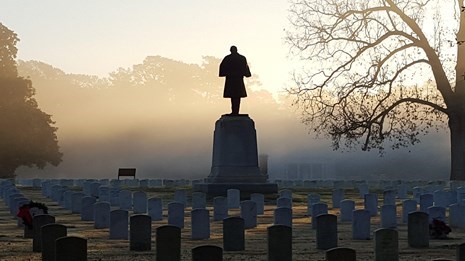Part of a series of articles titled Creative Teaching with Historic Places: Selections from CRM Vol 23 no 8 (2000).
Article
Teaching with Historic Places in the Parks: On Site/Off Site, Students Learn about Andersonville

Published by the National Park Service, Cultural Resources
by Alan Marsh
One of the most memorable weeks of my National Park Service career took place several years ago in Virginia while attending a workshop to write a Teaching with Historic Places (TwHP) lesson plan for Andersonville National Historic Site. It is rather hard to describe the emotion as I ate, slept, and lived in Montpelier, the home of James and Dolley Madison. In addition, one day during that week was Constitution Day. Although I looked for the ghost of the “Father of the Constitution,” James Madison did not appear and the day and night passed without incident. Still, I felt overwhelmed with the realization that I was in a historic place during such a very special time (not to mention feeling a little guilty that others did not have this same opportunity and experience).
During that week of working on the TwHP lesson for Andersonville, I realized that the educational materials that I and fellow workshop participants were developing had the potential to touch many people. I hoped that they would encourage students to learn more about this country’s historic treasures, events, and people. For many students in many grade levels, the study of history means sitting in class, listening to a lecture, and memorizing dates. These ways of studying history do have their place, but history is so much more than that. Accolades to the educator who can relate history to the student and make it come alive in the student’s imagination!
One tool that can help educators reach this goal is the series of TwHP lesson plans. They are easy to obtain and provide quick reference material on a multitude of historic places. One of the advantages of the TwHP series is that the information can be used in a variety of ways. Educators can use the material to teach students who are unable to visit a historic site, prepare students who will visit the site, or conduct a post-visit “follow-up” or refresher for students who visited a historic site.
The Andersonville lesson has been used in all three ways mentioned above. Students from as far away as Virginia have used the lesson to examine the Civil War prison camp before visiting. Jim Percoco has brought his Springfield, Virginia applied history students to Andersonville several times. Because the park staff know that the students already have made good use of the lesson plan and other information, the staff person who gives the tour of the prison camp and national cemetery can delve beyond the basic story and provide deeper insight into the administration of the prison and prisoner relationships to the guards and each other. Not only has the lesson plan provided students with insight and information regarding the prisoner of war camp, but perhaps just as importantly it has instigated discussions and questions. The students who want to learn more, arriving at Andersonville with insightful questions and emotions derived from the knowledge that many individuals, North and South, suffered tremendously at this place. They realize that among the Union prisoners of war buried in the cemetery are young boys, African Americans, American Indians, Caucasians, Hispanics, and even a woman who had concealed her identity. Students realize that everyone faced the same conditions and that survival was more important than background. The students can relate to these individuals. They have a connection with the people who were here.
It is not only important but imperative that we continue to introduce students to the many historic places in this country. TwHP is an idea avenue for this agenda. This unique series can help keep the history of our historic places fresh in the hearts and minds of today’s students. There is an inscription on the Wisconsin Monument at Andersonville which reads: “To Live In Hearts We Leave Behind Is Not to Die.” The Teaching with Historic Places series is a positive steps to educate students with interesting, pertinent information that will make history mean something to them and perhaps even been enjoyable in the process.
At the time of writing, Alan Marsh was Cultural Resource Specialist, Andersonville National Historic Site, Georgia.
Last updated: July 2, 2019
